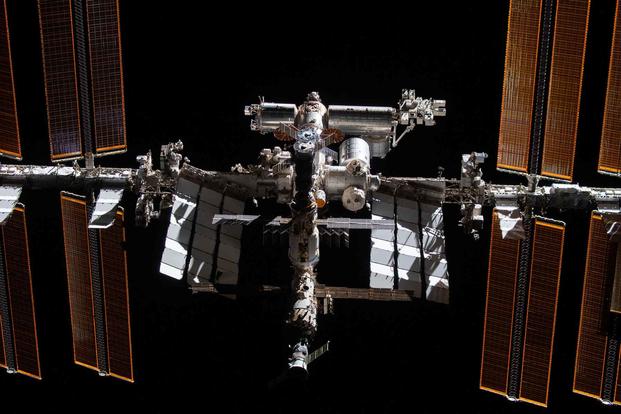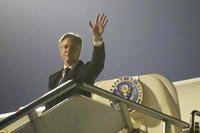An approaching federal contract deadline may reveal the solution to an urgent problem facing the U.S. space program: how to safely deorbit the International Space Station in the event of an emergency or when its mission wraps up.
Companies have until March 4 to turn in their proposals to "design, develop, manufacture, test, integrate, achieve NASA acceptance, deliver, and sustain" what the space agency is calling the United States Deorbit Vehicle, envisioned as "a new or modified spacecraft using a large amount of propellant."
NASA plans to award the contract in June for the one-of-a-kind vehicle meant to dock with the space station and safely "perform ISS attitude control, ISS translational maneuvers, and the final ISS orbit shaping and reentry burns" so that it hopefully -- fingers crossed -- ultimately crashes into the ocean without dropping debris over any populated areas.
Read Next: Army Sees Sharp Decline in White Recruits
U.S. military astronauts have frequently served onboard the ISS since its first long-duration expedition, Expedition 1, launched in 2001 with then-soon-to-be-retired Capt. William Shepherd, a Navy SEAL, in command.
A total of 45 U.S. military astronauts have served on 59 of the 70 numbered ISS expeditions to date, according to a Military.com analysis, while others visited briefly or took part in its assembly during their space shuttle missions going back to 1998.
In fact, a military astronaut holds NASA's record for the longest single spaceflight -- and for one of the very reasons that an independent safety oversight board suggested that the agency come up with a better ISS end-of-life plan.
A physician and helicopter pilot, retired Army Lt. Col. Frank Rubio, set the current U.S. record of 371 days in space after the capsule in which he was scheduled to fly back to Earth, a Russian Soyuz, sprang a coolant leak in 2022, extending his stay. Retired Army Col. Mark Vande Hei is in second place with 355 days, followed by retired Navy Capt.-turned-U.S. Sen. Mark Kelly with 340.
The Aerospace Safety Advisory Panel, an independent advisory board given additional responsibilities after the space shuttle Columbia disaster, recommended in 2022 that NASA address the growing likelihood of an emergency involving the space station and "the lack of a well defined, fully funded, controlled re-entry and de-orbit plan for the ISS that is available on a timeline that supports the planned ISS retirement."
That retirement has now been extended from 2024 until 2030 by four out of five international partners. So far, Russia has agreed to keep going only until 2028, according to NASA.
The advisory board said it considered the 2023 request for proposals for a deorbit vehicle as "initially responsive" to its recommendation. NASA later said in a statement that it spent years working on a prior strategy of using multiple Roscosmos Progress spacecraft for a future deorbit of the space station. But the agency concluded that "a new spacecraft solution would provide more robust capabilities for responsible deorbit." Progress is Russia's autonomous ISS cargo ship.
A NASA official said in 2023 that the cost for the new vehicle would likely approach $1 billion, and the agency asked for $180 million in its fiscal 2024 budget request. Congress is still negotiating the government's fiscal 2024 budget and has announced only an agreed-upon framework for military and non-military spending.
A U.S. Deorbit Vehicle may be ready in time for the planned deorbiting after 2030 but may not be in place if an emergency arises sooner -- such as a collision with space debris that knocks the space station out of commission, or the malfunctioning of an aging component or docked vehicle such as the leaky Soyuz. Other leaks have also dogged crews in recent years.
Officials have acknowledged that even the repurposing of an existing spacecraft to build the deorbit vehicle will take "years." Recent ISS-bound vehicles have taken as little as about six years to enter service for the first time.
That was the case with SpaceX modifying its Dragon cargo capsule into the new workhorse of U.S. human spaceflight, the astronaut-ferrying Crew Dragon. On the other hand, Boeing's Starliner crew capsule, contracted at the same time as Crew Dragon in 2014, is still in flight testing.
The last time the U.S. had to deorbit a space station -- the reentry of the comparatively compact Skylab in 1979 -- flight controllers had little meaningful control, and estimates suggested that it would hit Canada. The little space station went into an out-of-control, end-over-end tumble, and NASA's efforts sent it so far past Canada that parts of it crashed in Australia.
Editor's note: This story was updated to correct a reference to the Aerospace Safety Advisory Panel's responsibilities.
Related: Lawmakers Pressure Air Force to Finally Make Space Command HQ Basing Decision













